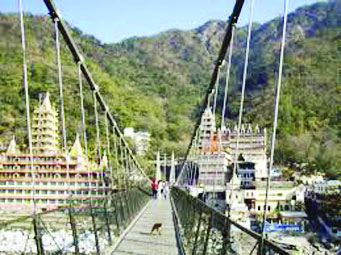The closure of the Lakshman jhula is another warning sign on the pressures of over-tourism in the Himalayas
Perhaps a great way to rewind family histories in India would be to turn the pages of a photo album and find generations frozen forever on the Lakshman jhula bridge in Rishikesh, all the way from sepia to instagram. Even Bollywood has relied on it as an eternal prop through the ages. That’s the span of the iconic suspension bridge, far more everlasting than the 137 m gap it closed on the Ganga and helped people transit from the Tehri to the Pauri side. And though it is being shut after years of gross overuse, for Indians it will never be a bridge too far. When it was first built in 1929, it served as a jeepable road for British India to transport men and materials and facilitate administration and connectivity in the hill states. But for locals, who believe that Lakshman crossed the river here on a rope way he made with Lord Ram and has probably the only temple in his name, it is about a gift from the Gods. Over time, it, along with Ram jhula, came the shortest and only transit corridor between both banks of the Ganga, ferrying everything from cows, buffaloes, bikes, jeeps and cars to locals, pilgrims, vendors and visitors. With more time, an entire economy grew around it, be it of the spiritual trail linking a group of temples, souvenir shops and food outlets and the quaint colonnades radiating from it. It also became Rishikesh’s best vantage point to watch the mystic river flow, the clear green waters full of fish on a sparkling day and a dark ripple catching flecks of a starlit night sky. With ever-increasing footfalls, the bridge had far exceeded its carrying capacity a long time ago. But its lifeline value far exceeded structural concerns. So when its sagging weight seemed to tilt the poles, the authorities rightfully decided to close it than risk a human catastrophe. In fact, the vintage Ram jhula will also be at risk as some traffic will tend to be diverted here. Authorities have promised another bridge but it will take some coming. They say Lakshman jhula itself was built because an earlier bridge was washed away in the floods. So one hopes an improved version, with latest technology and factoring in today’s demands better, continues a much-trusted legacy. Meanwhile, locals will have to depend on the boat crossings that pose a challenge to the waters and fish. Besides the waters are not safe during floods and the monsoon.
The fate of Lakshman jhula is a warning sign of the over-exploitation and over-tourism posing a serious challenge to the hill economy. And places like Rishikesh, which serve as a base town and a resource hub for both adventure and pilgrimage trails, have indeed come under tremendous pressure in terms of providing basic services like adequate hotel rooms, water and electricity. The Uttarakhand High Court had to ban all water sports and paragliding camps in the state, citing water pollution, ecological damage, and garbage piling up on beaches and hills, mostly around Rishikesh. River rafting in Uttarakhand is hugely popular, especially with weekend travellers from Delhi, and generates sizeable business. Thailand and the Philippines are already shutting down over-run tourist sites at the cost of the exchequer and laying new guidelines to open them once they recover. There is an urgent need for eco-friendly guidelines and rationed permits on the basis of an impact assessment report until 2050. Except for the Amarnath yatra, there are no unified codes for the Char Dham yatra yet. Because without sustainable and equitable tourism, the Himalayas may turn into a wasted paradise
Courtesy: Editorial-The Pioneer








 OpinionExpress.In
OpinionExpress.In















Comments (0)